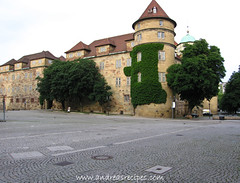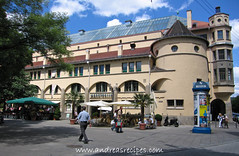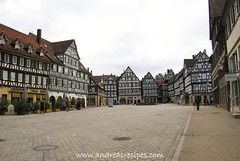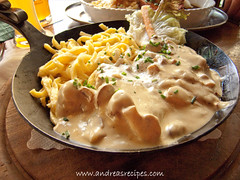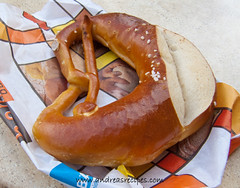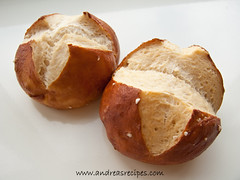When many travelers think of Germany, they think of Berlin and Munich or the Rhine wine country, but there are other wonderful cities and states to visit, and Stuttgart and the state of Baden-Württemberg should be on the list. It is on the border of the Black Forest (Schwarzwald) region and is a business center for the auto industry and the U.S. military. There is plenty to see in the Stuttgart area and it’s an easy city to travel in and out of to see other parts of Baden-Württemberg. Here are some notes from my recent trip to the area.
Getting Around
The public transportation system is very good and can get you just about anywhere you want to go in and around Stuttgart. The main train station (Hauptbahnhof) and bus station (Zentraler Omnibus-bahnhof) in downtown Stuttgart is the center of travel and most of the local, regional, and national trains stop here each day. If you plan to use the trains (S-Bahn and U-Bahn) to get around Stuttgart, a day ticket is the way to go. For a fixed fee of €12,00, you can go anywhere in the system and get off as many times as you want until the daily end of transportation service. You can also purchase a group or family all day ticket for 1 to 5 adults which allows any number of children under the age of 17. A bicycle or dog counts as one person on the ticket. All of these tickets can be purchased for the current day or a future date. For longer stays, check into a weekly or monthly ticket. All types of tickets can be purchased through the machines at each train station.
Walks
There are good places to stroll in the Stuttgart city center, and you can see many of the architectural and cultural sights all within a mile or two. The strolling area is accessible via the trains. S-Bahn stops include Stadtmitte and Hauptbahnhoff, and U-Bahn stops include Arnulf-Klett Platz, Staatsgalerie, Neckartor, Schlossplatz, Charlottenplatz, Rathaus, Rotebühlplatz, and Friederichsbau.
The Königstrasse is the main shopping street, a large pedestrian-only street that is supposedly the longest in Germany. Königstrasse leads to the Schlossplatz where the New Castle (Neues Schloss) is located, and also runs past Schillerplatz where the Old Castle (Altes Schoss) is located.
Take a few turns behind the Altes Schloss and you’ll find the Markthalle and the Rathaus with the glockenspiel where they hold an outdoor market.
Other places to see include the Staatstheater, Wilhelmpalais, the Wilhelma Zoo, and a number of museums. If you visit in the month of December you can see the Stuttgart Christmas Market, one of the largest in Germany.
One street over from Königstrasse, Calwer Strasse is full of cafes where you can dine indoors or out.
Museums
Stuttgart has no shortage of museums, and you can choose between a number of art and cultural museums, even a musical instrument museum. Eleven of the museums are clustered within an area of several blocks around the Altes Schloss and Neues Schloss, and the Mercedes-Benz Museum and Porsche Museum are located on the outskirts of the city, easily accessible via the S-Bahn. The Mercedes Benz Museum is the largest indoor car museum in the world and automobile enthusiasts can easily spend a few hours there. Some of the museums are free and others require Euros for entrance.
Old Towns and Castles
Several historic towns and castles are easily accessible via the S-Bahn and U-Bahn trains running through the region, most within 30 minutes or less of the main train station (Hauptbahnhof).
- Esslingen am Neckar, a medieval town with some historic buildings in the center of town (Stadtmitte). Take the S1 train towards Plochingen, get off at Esslingen and then follow signs to the Stadtmitte after exiting the train. The train goes through wine country, so look for the vineyards on the hills to the left as you travel.
- Schorndorf (link in German), a medieval town with historic Marktplatz and church. Take the S2 train to Schorndorff (the end of the line). As you exit the train and cross the street, you will be in the historic part of town. Has a popular outdoor market on the Marktplatz on Tuesdays and Saturdays and is known for their outdoor Christmas market (Weighnachtsmarkt). Birthplace of Gottlieb Daimler.
- Weil der Stadt, medieval walled town with historic church. Take the S6 train to Weil der Stadt, then from the Bahnhof walk along Postrasse following signs to the Stadtmitte. Has a small Marktplatz with a museum that is only open on Sundays from 2 pm to 5 pm. The Sts. Peter and Paul Church is on a hill overlooking the town, not open on Wednesdays. Birthplace of Johannes Kepler. Had the best brezel (pretzel) I have ever tasted in my life at the Penz Bäckerei und Konditorei on Poststrasse.
- Ludwigsburg Schloss, Baroque castle with Fairy Tale Gardens. Take the S4 or S5 train and get off at Ludwigsburg. Ludgwigsburg is one of the largest castles in the area. Need Euros for entrance fee.
- Leonberg, a castle with a terraced garden dating back to the Renaissance, the only remaining in Germany. Also has a famous horse market in February each year. Take the S6 train.
- Waiblingen, a medieval town with a watch tower and museum. Take the S2 or S3 to Waiblingen.
- Backnang, a medieval town with an historic church. They have an outdoor festival (Strassenfest) each year during the last week in June. Take the S3 train to Backnang.
Swabian Cuisine
The state of Baden-Württemberg is part of the region known as Swabia, which is known for its hearty dishes. We enjoyed several Swabian specialties while on our trip.
kartoffelsalat (potato salad with a white wine vinegar sauce)
brezel (pretzels)
laugenbrötchen (pretzel rolls)
Wine Tours
The area east of Stuttgart is one of Germany’s wine-producing regions, and several of the wineries offer tours and tastings during the months of January through April and October through December. The Stuttgart wine trail (Weinwanderweg) runs for 12 kilometers through towns with picturesque hillsides full of vines and can be done as a walk, taking about four hours to complete, or you can do a shortened version and take buses back to the Oberturkheim bahnhof. The walk takes you through the towns of Obertürkheim (train station), Uhlback, Rotenberg, and ends at Untertürkheim (train station). There is a wine museum in Uhlback (Uhlback Viniculture Museum) that tells about the history of winemaking and offers tastings, which is open March to November just on Saturdays, Sundays, and public holidays .
Holidays
Baden-Württemberg celebrates some religious holidays as bank holidays and many stores close, though some museums and other sights have special hours for holidays. Plan ahead and check with any sights you plan to visit for holiday hours. You can find a complete listing of bank holidays around the world at www.bank-holidays.com.
More Information
The organization Stuttgart Marketing GmbH has a number of brochures with museum and tour listings in both English and German. You can find more information on sight seeing in Stuttgart and the surrounding area at their website www.stuttgart-tourist.de.
What If You Are Moving to Stuttgart?
For families moving to Stuttgart from overseas, you will need specific information about how to find a place to live and schools. The International School of Stuttgart is a good place to start looking for a school with English as the language of instruction. You can also find information about living in Germany at the U.S. Embassy Germany website.

